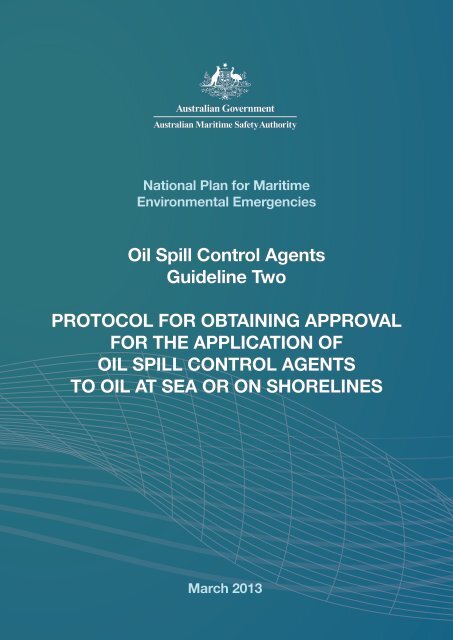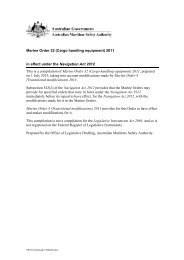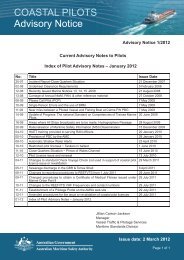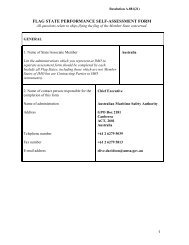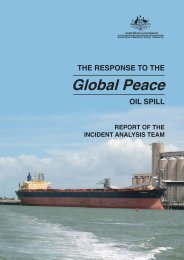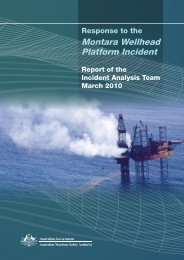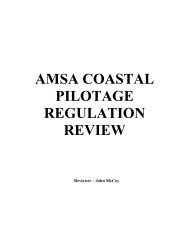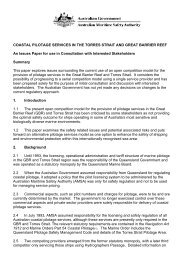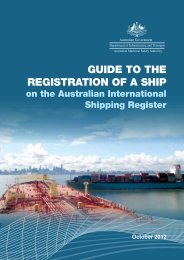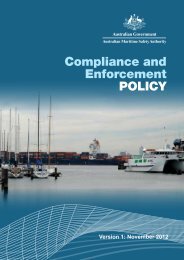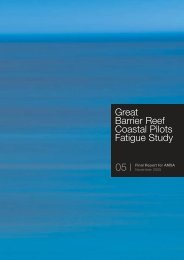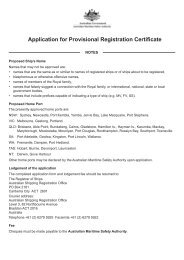Protocol for obtaining OSCA approval. - Australian Maritime Safety ...
Protocol for obtaining OSCA approval. - Australian Maritime Safety ...
Protocol for obtaining OSCA approval. - Australian Maritime Safety ...
Create successful ePaper yourself
Turn your PDF publications into a flip-book with our unique Google optimized e-Paper software.
National Plan <strong>for</strong> <strong>Maritime</strong>Environmental EmergenciesOil Spill Control AgentsGuideline TwoPROTOCOL FOR OBTAINING APPROVALFOR THE APPLICATION OFOIL SPILL CONTROL AGENTSTO OIL AT SEA OR ON SHORELINESMarch 2013
AMSA TRIM D12/97269
PurposeThis Guideline sets out a best practice decision-making process <strong>for</strong> oil spill control agent (<strong>OSCA</strong>) <strong>approval</strong>application and use. It assists in answering the questions:• Is an <strong>OSCA</strong> required?• What in<strong>for</strong>mation is required <strong>for</strong> <strong>approval</strong>?• How should the decision-making process be recorded?It is intended to support rapid, well-in<strong>for</strong>med, and well documented decision-making.Regulatory <strong>approval</strong> and incident controller agreement are bothnecessaryOil spill control agents are chemical <strong>for</strong>mulations (such as dispersants, surface cleaners, bioremediation agentsand loose sorbents) that are released into the natural environment during a spill response to improve clean-upresults. Their use must be approved by the relevant Statutory Authority. This authority will be either the State/NTor Commonwealth government having jurisdiction over the area, depending on whether the <strong>OSCA</strong> is to be usedat sea, in estuaries or on coastal land.Under the National Plan <strong>for</strong> <strong>Maritime</strong> Environmental Emergencies, Oil Spill Control Agents can be listed onthe <strong>OSCA</strong> Register. To gain acceptance on the Register, <strong>OSCA</strong>s must successfully pass tests on efficacy,ecotoxicology and biodegradation. The specific requirements <strong>for</strong> each <strong>OSCA</strong> are outlined on the AMSAwebsite page National Plan Register of Oil Spill Control Agents.Note: Use of <strong>OSCA</strong>s in fully freshwater systems is not dealt with in this <strong>Protocol</strong>.As the purpose of using an <strong>OSCA</strong> is to gain a beneficial outcome <strong>for</strong> both the spill clean-up and <strong>for</strong> the effectedenvironment, the approving authority must be provided with evidence that good decision-making processeshave been followed. It will need to know if:• using the <strong>OSCA</strong> will be effective• alternative cleaning options have been considered• the effects of the oil and the oil/<strong>OSCA</strong> mix on the environment have been assessed (net environmentalbenefit assessment)• there are any safety issues <strong>for</strong> the public or operators.Evidence may come from the results of monitoring and testing, or come from expert advice. It is important thatthe reasons <strong>for</strong> providing <strong>approval</strong> are well documented and that these are regularly re-assessed and furtherdocumented, throughout the response.Approval <strong>for</strong> the use of oil spill control agents at seaFigure 1. outlines the sequence of considerations and decision-points (expressed as questions andassessments) required to assess whether an <strong>OSCA</strong> should be used in the marine environment. Figure 3. doesthe same <strong>for</strong> shoreline application. Guidelines <strong>for</strong> determining the answer at each decision-point are providedbelow.A pro<strong>for</strong>ma “Request <strong>for</strong> Approval <strong>for</strong> the Use of Oil Spill Control Agents at Sea” (<strong>OSCA</strong> P2.1) is provided inAttachment 1.1
Figure 1. Guideline <strong>for</strong> determining whether to apply <strong>for</strong> <strong>approval</strong> to apply Oil Spill Control Agents to oil at sea.1. Have alternative 'at sea'response actions beenconsidered?NoAlternative 'at sea' response options:- Monitor / natural dispersionYes2. Is oil heading towards asensitive area?NoNo- Containment & recovery- Inshore & shoreline protection- Shoreline clean-upYes3. Is the oil amenable totreatment?Yes4. Is the effect of the treatedoil likely to be less than theeffects of the untreated oil?Monitor and reviewNoMonitor and reviewNoYes5. Have necessary regulatory<strong>approval</strong>s been obtained?Yes6. Can <strong>OSCA</strong>s be applied safelyand effectively?Yes7. Is the treatment effective?NoNoDevelop an<strong>OSCA</strong> Sub-plan& apply <strong>OSCA</strong>NoAlternative 'on-shore' response:- Monitor / natural recovery- Shoreline protection- Shoreline clean-upYes8. Has the objective beensuccessfully achieved?ContinueNoYesJob done2
At sea use decision points1. Have alternative ‘at sea’ response actions been considered?In general, the applicability and suitability of the full range of marine oil spill response strategies will havebeen considered during the preparation of any oil spill contingency plan (OSCP) produced <strong>for</strong> the area oractivity. Where one exists, the OSCP will identify the response methods and the conditions under whichthey can be used. Where an OSCP does not exist, general approaches to oil spill response should beconsidered and documented, as needed.During the spill response, these options should be reassessed in light of ambient conditions and thenature of the incident. This is the role of the Incident Controller (IC) in consultation with other IncidentManagement Team (IMT) officers.<strong>OSCA</strong> Form P2.1 (Attachment 1) provides guidance on what other alternative response strategies andmethods are feasible. However, the final decision on a particular operational approach always resideswith the IC in consultation with the IMT officers.2. Is the oil heading towards a sensitive area?Three key pieces of in<strong>for</strong>mation are required to make this assessment:• The oil character and behaviour, particularly persistence.• The oil spill ‘slick’ trajectory (direction and speed of travel, and the rate of spread)• The environmental character of the ‘zone of potential impact’ of the oil (resources, species,habitats, value, and likely effects of contact with the oil)Oil character and behaviourSome oils weather rapidly and may be removed from the sea surface through evaporation of physicalbreak-up of the slick. This may occur be<strong>for</strong>e and impact on a sensitive resource can happen. Oil spilltrajectory modelling should provide a good indication of oil persistence and indicate this against thetime of shoreline impact. However, it is also worth checking the oil’s analytical data if it is available. Inparticular:• Specific gravity; this is an indicator (but only an indicator) of oil volatility. Light oils will generally losemuch of their volume due to evaporation.• Wax content. Waxes are persistent and will reduce the evaporative losses of an oil.• Pour point, some oils (particularly high wax oils) may have a high pour point. Below this temperaturethey will be solid or else highly viscous. If the ambient temperature is close to the oil’s pour point thenit will weather more slowly.• Asphaltene content. High asphaltene oils tend to emulsify. This causes them to persist <strong>for</strong> longer atsea.It is important that predicted oil behaviour is verified through aerial surveillance and field reportingthroughout the response.Oil spill trajectoryComputer-based oil spill trajectory models (OSTMs) can provide quite accurate results, but modellingoutput may take time. Manual calculations may be used initially. The following in<strong>for</strong>mation should beobtained:3
• Direction of slick travel and speed• Extent (spread, thickness and volume) of the oil. Determining the area covered by oil, and its charactercan assist with estimating slick volume. This is critical is estimating the likely effectiveness of all responseoptions, including containment and recovery operations. Note, extent and volume are extremely difficult toestimate manually – they require expert assessment.• Resources at risk - that are likely to be hit and impacted (see paragraphs below <strong>for</strong> more detail). These alsorequire expert assessment.• Time to impact. This determines the required response time and may be a significant consideration indeciding on the application of dispersants.Environmental resources at riskIf a shoreline impact is likely the relevant Oil Spill Response Atlas (OSRA) should be consulted in order todetermine the resources likely to be affected. The OSRAs do not generally list the sensitivity of marine shorelineresources, but Attachment 2 provides examples of sensitive resources and areas. Wherever possible, expertopinion or evidence should also be sought.3. Is the oil treatable?This will depend on a number of factors including:• Oil character (initial and at the current stage of weathering).• Dispersant (or other <strong>OSCA</strong>) type.• Method of application.• Sea state (energy).Preliminary assessmentIf the oil has not been tested then the guidelines in Table 1 can be used as a preliminary assessment of whetheran oil is likely to be amenable to treatment, especially <strong>for</strong> dispersants. There is less in<strong>for</strong>mation regarding theamenability of various oils to treatments with other <strong>OSCA</strong>s.Field testing of dispersant effectivenessIf the oil type or weathering condition is not known then a field test of dispersant effectiveness on oil at sea canbe undertaken. Guidance <strong>for</strong> this test is on our website.However, it is difficult to simulate application rates and mixing energy in this test and consequently results ofthis method are not always accurate. They provide indicative data only.Trial runsIn the absence of better data, it may be necessary to run a small test application of the <strong>OSCA</strong> onthe spilt oil at sea and observe its effectiveness. For dispersants, this may be necessary every newoperational period (day) simply to assess continuing effectiveness as oil weathers over time.4
Table 1. Indications <strong>for</strong> effective dispersant useParameterOil is generally dispersible 1 if:Oilcharacter 2 DensityPour pointViscosity 4 attemperatureThe specific gravity: is less than 0.95 (i.e. >17 API)Is > 5 o C below ambient sea surface temperature (non waxy oil)Is below ambient sea surface temperature (waxy oil) 3v. unlikely >10,000 cSt under mostconditionsambientuncertain 5,000 - 10,000 cSt good conditionspossible 2,000 – 5,000 cSt good conditionslikely
Figure 2 shows a typical “Decision Tree” <strong>for</strong> undertaking a rapid NEBA. It should be noted that all availablein<strong>for</strong>mation must be assessed in order to make justifiable assessments.5. Have necessary regulatory <strong>approval</strong>s been obtained?Approval agencies and other agencies that must be consulted are listed in the National Plan <strong>for</strong> <strong>Maritime</strong>Environmental Emergencies (National Plan) or in the relevant State Plans.Figure 2. Guideline <strong>for</strong> determining the likely Net Environmental Benefit of using oil spill control agents on oil at sea.Aerial surveillanceSatellite imageryOSTMSea stateWeathering dataLogisticsOil dataSea stateWeathering dataLogisticsOil dataNEBAWill oil impact orsignificantly affectsurface fauna?Will oil impacteconomicresources?Will oil <strong>for</strong>mtarballs oremulsions?Will oil impactcoastalresources?YesYesYesYesYesYesYesYesWill other marinestrategies significantlyreduce risk?Will other marinestrategies significantlyreduce risk?Will other marinestrategies significantlyreduce risk?Will other marinestrategies significantlyreduce risk?NoNoNoNoWill <strong>OSCA</strong> usesignificantly reducerisk?Will <strong>OSCA</strong> usesignificantly reducerisk?Will <strong>OSCA</strong> usesignificantly reducerisk?YesYesYesImplement alternativemarine responsestrategiesImplementshoreline responsestrategiesConsidernaturalrecoveryYesNoWill shorelineresponse significantlyreduce harm?Shoreline dataNoAre risks posed by<strong>OSCA</strong> useacceptable?YesRequest <strong>approval</strong><strong>for</strong> <strong>OSCA</strong> use atsea6
6. Can <strong>OSCA</strong>s be applied safely and effectively?This assessment will generally be undertaken by the Operations Unit of the IMT with input from the Health and<strong>Safety</strong> Coordinator (if appointed). Guidelines <strong>for</strong> dispersant application are provided in Table 2. In<strong>for</strong>mation <strong>for</strong>other listed <strong>OSCA</strong>s should be available in the relevant documents available with the product or on the NationalPlan <strong>OSCA</strong> Register website.Table 2. <strong>Safety</strong> constraints <strong>for</strong> dispersant application.MethodAerialApplication(Fixed Wing)Conditions <strong>for</strong> the Safe and Effective Application of DispersantsWindLess than or equal to 25 knotsVisibilityGreater than 5.5 km (3 nmiles)Ceiling >300mProximity to CoastShould not be closer than XXX kmShould not be further than (consult aircraft safety manual)AerialApplication(Helibucket)VesselApplicationOtherWindVisibilityCeilingOil Proximity to CoastOtherSea StateOtherDaylight onlyLess than or equal to 25 knotsGreater than 5.5 km (3n miles)XXXShould avoid drift of <strong>OSCA</strong> on shore.Should not be further than XXX km (safety)XXXSuitable PPE must be available <strong>for</strong> responders (refer to the product MSDS)Note: For extended responses or those being undertaken under difficult conditions it may be advisable todevelop an Activity <strong>Safety</strong> Plan or include safety provisions within an <strong>OSCA</strong> Sub-Plan (see below).Development of an <strong>OSCA</strong> Sub-PlanThis Sub-Plan should set out the procedures <strong>for</strong> applying <strong>OSCA</strong>s and also include any health and safetyrequirements (PPE) and procedures. This Sub-Plan should reflect the scale of the application, the sensitivity ofthe receiving environment and any risks posed by the <strong>OSCA</strong>. It should be as simple as possible. The Sub-Planshould include:• Objective; an appropriate “end point” at which the <strong>OSCA</strong> application is deemed to have been successful• Management responsibility (nominated officer in charge)• Operations- Methods- OSTM type and volumes available- Constraints (no go areas, depth restrictions etc.)- <strong>Safety</strong> ( handling, storage and PPE needs)• Logistics- Vessel or air base- Monitoring of total volumes used use (<strong>for</strong> resupply)7
• Record keeping- Location, volumes used, dates7. Is treatment effective?The use of <strong>OSCA</strong>s must be monitored to ensure that the application is, and remains, effective. Oil will weatherand conditions will change and so this reassessment is ongoing.8. Has the operational objective been successfully achieved?This is an operational decision based on monitoring of the oil slick and <strong>OSCA</strong> application.Shoreline application decision points<strong>OSCA</strong>s that may be used on shorelines include, dispersants specifically tested and accepted <strong>for</strong> this, otherwashing agents and loose sorbents. The last of these are generally recovered and so there maybe no runoffwith this method. Bioremediation agents may also be applied. These are longer-term treatments.Figure 3 outlines the sequence of considerations and assessments required <strong>for</strong> assessing the use of <strong>OSCA</strong>s onshoreline. This process is essentially the same as that <strong>for</strong> marine application but the in<strong>for</strong>mation that is needed<strong>for</strong> each decision or assessment is different. Each step is discussed below.1. Have alternative on-shore response actions been considered?Generally, <strong>OSCA</strong>s are considered <strong>for</strong> use onshore only if:• There is a need to remove oil more rapidly than can be achieved with alternative methods.This could be due to:- Human safety concerns- Potential <strong>for</strong> ongoing exposure of wildlife (e.g. seal haul-out areas, bird nesting)- The need to cause minimum noise of other human effects (e.g. nesting birds)• Alternative methods are not possible, (e.g. lack of access coupled with a large impact area)• Other methods are potentially damaging (e.g. most methods in wetlands)2. Is oil likely to be persistent?Oil may persist on shorelines if:• It has penetrated into sediment or crevices (or buried) where washing energy of tides and waves is low.• It is sticky (and washing energy from waves is low). This may occur if oil weathers to tarry or asphaltresidues.• The shoreline is sheltered and very low energy.3. Is the oil treatable?This will depend on a number of factors including:• Oil character (initial and at the current stage of weathering)• Nature of the substrate oiled• Depth of oil in sediments• <strong>OSCA</strong> type• Method of application. For washing agents this will include the pressure of washing and temperature of<strong>OSCA</strong> and water applied.8
• Wave energy (if artificial washing is not applied after <strong>OSCA</strong> application)Generally, oils are not tested <strong>for</strong> “stickiness” and it may be necessary to undertake a test application of cleaningagents in order to determine the best method of application and overall effectiveness.Figure 3. Guideline <strong>for</strong> Determining Whether to Request <strong>for</strong> Approval to Apply Oil Spill Control Agents to Oil on Shorelines.1. Have alternative 'on shore'response actions beenconsidered?NoAlternative 'on shore' response options:- Monitor / natural recoveryYes2. Is oil heading towards asensitive area?NoNo- Mechanical recovery- Manual recovery- Washing (without <strong>OSCA</strong>s) etcYes3. Is the oil amenable totreatment?Yes4. Is the effect of the treatedoil likely to be less than theeffects of the untreated oil?Monitor and reviewNoMonitor and reviewNoYes5. Have necessary regulatory<strong>approval</strong>s been obtained?Yes6. Can <strong>OSCA</strong>s be applied safelyand effectively?Yes7. Is the treatment effective?NoNoDevelop an<strong>OSCA</strong> Sub-plan& apply <strong>OSCA</strong>NoAlternative 'on-shore' responseoptions:- Shoreline protection- Shoreline clean-up- Monitor / natural recoveryYes8. Has the objective beensuccessfully achieved?ContinueNoYesJob done9
4. Is the effect of the treated oil likely to be less than the effect of untreated oil?This requires a Net Environmental Benefit Assessment (NEBA). The undertaking of a NEBA <strong>for</strong> shorelineresponse is considerably more complex than that <strong>for</strong> at sea response. This is because:• There are more response options, and a number of these options can be damaging to shorelines andshoreline ecology.• The potential <strong>for</strong> damage may be highly dependent on levels responder competency and supervision andother variables such as washing pressure or the type of equipment deployed.• Variability of shoreline character and consequent variability of sensitivity to oil and clean-up activities.Furthermore, <strong>OSCA</strong>s are often used onshore in association with other cleaning methods rather than as asubstitute treatment. The advantage that <strong>OSCA</strong>s often bring is of a more rapid and thorough cleaning. TheNEBA assessment there<strong>for</strong>e may need to compare a higher short-term level of harm against a more speedyrecovery, i.e. reduced longer term harm.5. Have the necessary regulatory <strong>approval</strong>s been obtained?Approval agencies and other agencies that must be consulted are listed in the National Plan <strong>for</strong> <strong>Maritime</strong>Environmental Emergencies (National Plan) or in the relevant State Plans.6. Can the <strong>OSCA</strong> be applied safely and effectively?The safety of both the public and OSR operators must be considered. This assessment will generally beundertaken by the Occupational Health and <strong>Safety</strong> Coordinator of the Incident management Team (IMT).Responder safety can be addressed through the provision of suitable PPE (as indicated in the product MSDS)and training of operators and other response personnel.For public safety, the short term and longer term exposure must be considered. Exclusion of the public duringand immediately after <strong>OSCA</strong> application should be mandatory.Longer term exclusion must be based on an assessment of likely persistence of the <strong>OSCA</strong> and associated oil,potential effects on humans and fauna and possibly on ongoing monitoring of the area until the treated area isdeclared clean.As with at sea applications a suitable <strong>OSCA</strong> Sub-Plan should be developed (see page 7).7. Is the <strong>OSCA</strong> application effective?The use of <strong>OSCA</strong>s must be monitored to ensure that the application is, and remains, effective. As oil andweather conditions change this reassessment is on-going.8. Has the operational objectives been successfully achieved?The ‘end point’ should be documented in the <strong>OSCA</strong> Sub-Plan.10
ATTACHMENT 1REQUEST FOR APPROVALFOR THE USE OF OIL SPILL CONTROL AGENTS AT SEAPart A - Request from:NamePosition (usual)IMT positionICC locationContact detailsTel:Fax:Incident nameMob:Email:Spill locationRequest DetailsDate of requestTime of request (24 hr)<strong>OSCA</strong> typeProduct name(s)Receiving environment: At sea Likely depths of receiving water body ___ mShorelineOther (specify)Note:Proposed applicationmethod(s):Fixed wing (light) Is FWAD mobilisation requested? yes noVesselHelicopter (spray bucket)Proposed location ofapplication:Lat:Other (specify)Lon:Comments/ additional requestsAuthorised byName:Position:Signature:Date:OSR Form No. <strong>OSCA</strong> P2.1 Page 1 of 411
Part B - Assessment detailsDecision Point 1: Have alternative marine response strategies been considered?(a) Monitor OnlyiOil moving towards sensitive resources / velocity and assessment of oil persistence indicate animpact on these.OSTM run? yes no ADIOS run? yes noComment:iiOSR monitoring resources not available (aircraft, landing sites, trained aerial observers).Comment:(b) Containment and RecoveryiResources inadequate/ spill area too large. Spill moving too fast/ too close to sensitive resources.Cannot recover oil be<strong>for</strong>e impact.OSRA/ESC consulted? yes noComment:iiSea states/ weather do not allow <strong>for</strong> safe or effective containment and recovery operations.Forward <strong>for</strong>ecast obtained? yes noSummary:(c) Shoreline (or Resource ) Protectioni Impact area (e.g. length of shoreline) is too large <strong>for</strong> adequate protection strategiesComment:iiInshore or onshore conditions make protection strategies unsafe or ineffective.<strong>Safety</strong> issues? yes no Shoreline energy too high? yes noComment:(d) Shoreline clean-upi Shoreline is sensitive to oil impact/cleanup. Presence of wildlifeComment:iiResources inadequate/ impact area too large/ Lack of or difficult access or logistics<strong>Safety</strong> issues? yes noComment:Additional CommentsOSR Form No. <strong>OSCA</strong> P2.1 Page 2 of 412
Decision Point 2: Is oil heading towards a sensitive resource(a) Has a trajectory analysis been undertaken? yes noManual calculation? yes no OSTM? yes no ADIOS? yes noPlease attach outputs(b) Is impact on sensitive resource anticipated? yes noResource:Location:Extent of oiling (est.):(c) Has a time of impact been estimated? yes no if yes, estimated timeAssessment/CommentDecision Point 3: Is the oil amenable to treatment?(a) Has oil data been obtained yes noComment or attach oil data(b) Has a field assessment/ test been undertaken? yes noResults(c) Assessment. Is oil currently likely to be amenable? yes noCommentDecision Point 4: Is the effect of the treated oil less than the untreated oil?(a) Has NEBA assessment been undertaken? yes noFindings (please attach NEBA)(b) Have relevant experts been consulted? yes noIf yes, who? (list)(c) Have resources likely to be impacted by treated oil been identified? yes noHow will risks be managed?OSR Form No. <strong>OSCA</strong> P2.1 Page 3 of 413
Decision Point 5: Have necessary regulatory <strong>approval</strong>s been obtained (other than this application)?(a) Are other <strong>approval</strong>s required? yes noIf yes, list(b) Have <strong>approval</strong>s been sought? yes noIf yes, list(c) Have other <strong>approval</strong>s been given? yes noIf yes, listDecision Point 6: Can <strong>OSCA</strong>s be applied safely and effectively?(a) Has <strong>OSCA</strong> Sub-Plan been prepared? yes no if yes, attach(b) Have MSDS been obtained assessed and distributed? yes noComment(c) Is all PPE and equipment held or on way? yes noIf yes, listNote: Statutory <strong>approval</strong> agencies must be advised of outcomes of:Decision Point 7 (Has treatment been effective) andDecision Point 8 (Have operational objectives been successfully achived?)of the <strong>OSCA</strong> Decision TreeOther commentsOSR Form No. <strong>OSCA</strong> P2.1 Page 4 of 414
ATTACHMENT 2Potentially Sensitive ResourcesResourceBirdsConsiderationsHighly sensitive and vulnerableMay congregate (seasonally) in large numbers <strong>for</strong> feeding, roosting, nestingCan be attracted to oil sheen (oil can mimic baitfish oil sheen)Difficult to clean (low survival rates)Mangroves and coastalswampsLow wave energy so oil may persistEcological character (community type, species, biodiversity)Difficult to clean without causing additional damageSocial and economic sensitivity to oil impact and cleaningOther shorelinesWave energy may offer other response optionsSocial and economic sensitivity to oil impact and cleaningPossibility of clean-up – access, substrate type (rock or sediment)Effects of clean-upPotential persistence of oil on (or in) sedimentsReefs, shoals and othershallow water communities(corals, seagrasses,sponges etc.)Character (community type, species, biodiversity)Depth (intertidal <strong>for</strong>ms are particularly vulnerable and sensitive)Sea states (vertical mixing of the oil)Oil character (stickiness)Fish breeding sites andaggregationsSeals and Sea Lions(Pinnipeds)Seasonal occurrenceSensitive to dispersed oil also. Consider the depth of occurrence.Difficult to treat when oiled.Congregate in large numbers seasonally at locationsBreeding, roosting/haul-out areas are of high sensitivityWhales and Dolphins(Cetaceans)Little evidence that adults are affected by oil or dispersed oilBreeding or nursing areas must be considered sensitivePresence of calves must be treated as sensitive15
AMSA 331 (03/13)


